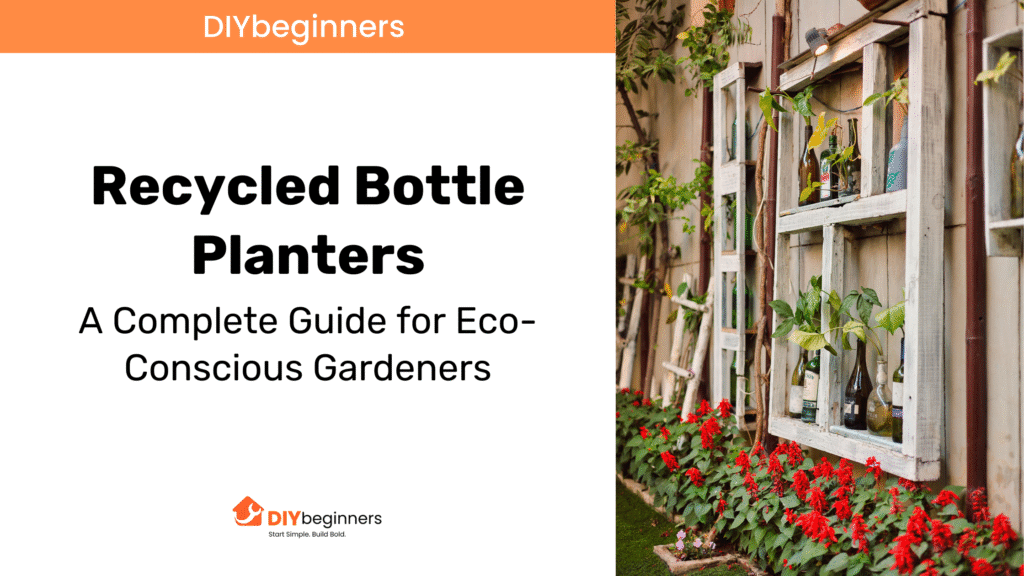
Introduction: Turning Waste into Garden Treasures
Recycling plastic bottles to make planters is a brilliant idea to reduce plastic waste nd to nourish your plants. The average individual uses about 156 plastic bottles per year, and 60 million bottles are being disposed of daily; thus, it has become important that people seek to find ways of repurposing these bottles in an innovative fashion. Worse still is the fact that half of these bottles are not being recycled now, and this has seen millions of bottles finding their way into the landfill or even into the ocean.
This tutorial will take you step-by-step through what you must know to turn drab-looking plastic bottles into terrific-looking and functional planters. Recycled bottle planters are the perfect gift that fits everyone since they not only help with environmental responsibility but also stay budget-friendly, whether you are an experienced gardener or a newbie.
How to Create Stunning Recycled Bottle Planters at Home
Becoming familiar with how to prepare bottle planters using recycled bottles is an enjoyable gardening DIY project, even when a gardener is a beginner. It is easy to do and only a few tools and supplies (that you may already have at home) are needed.
1. Basic Materials You’ll Need
- Clean plastic pesticides (water bottle, sun drink).
- Scanner, or craft knife.
- Twintwine/yarn for self-watering systems.
- Potting soil
- Nyembreeds or young plants
- Additional decorative materials (optional: paint, etc., fabric
2. Step-by-Step Guide to Recycled Bottle Planters
1. Creating a Simple Planter
- Prepare the bottle: Clean the bottle thoroughly and remove the labels.
- Cut the bottle: To make a simple planter, use a horizontal cut on the bottle that is one-third of the way from the top of the bottle.
- Make holes at the bottom to allow the drainage of water.
- Incubate in dirt: Put in dirt.
- Plant your seedlings: Put your plant of choice in a seedling.
- Water the new plants: Give your new plants a light general watering.
Follow this easy-to-follow tutorial to make recycled bottle planters and enjoy some growing containers made of waste products easily.
2. Making Self-Watering Plastic Bottle Recycled Pots
- Hack the bottle: In the method as indicated above, cut the bottle to leave only two pieces.
- Making a wick: Thread cotton yarn/twine through the bottle cap (a hole in it should be small).
- As it is, prepare the reservoir: In the bottom part, fill with water.
- Make the planting space: Fill the upside-down top part of it with soil, leaving the wick to protrude into it.
- Assemble the parts: Insert the part with the soil in the reservoir of water (cap down).
Such a design enables the contents of the wick to rise to a great height as a result of capillary action, thereby maintaining a steady moist soil without waterlogging.
Creative Plastic Bottle Planters You Can Make Today
Paint or fabric-decorated plastic bottle plans are a fun way to decorate unused plastic bottles to give your garden a certain flair and use the recycled materials to save the earth. These planters are light and they are non heavy, thus thou has the choice of rearranging the patterns of the garden anytime you want. They have lots of imaginative solutions (converting bottles into fun, silly animal-shaped plant holders like bunnies, frogs, or pigs using nontoxic paint and items to decorate them with).
Bottles may also be cut horizontally, holes drilled in the bottom, and hung up by using strong string or wire to make hanging gardens. Vertical gardens make a great choice in smaller areas, wherein several bottles may be hung on a fence or a wall in order to create a living wall. Seasonal touches give an extra bit of appeal, whether planters are associated with holidays such as Valentine’s Day or Christmas.
DIY recycled plastic bottle planters offer an unlimited range of customization options: Not only are they a convenient plant container with eye-catching beauty, but they are also a form of decorative art that expresses your personality.
Best Plants for Recycled Plastic Bottle Planters
For Indoor Use
- Herbs: Basil, mint, chives, and parsley thrive in old water bottles.
- Such as Succulents: These easy-to-care-for plants require low water and do well in small pots.
- Spider Plants: They are a great choice for bottle environments as air purifiers.
- Peace Lilies: Blooming peace lily plants can live well in self-watering container systems.
For Outdoor Use
- Strawberries: Strawberries can be planted well in hanging bottle planters.
- Lettuce and Greens: Larger bottle containers are good for leafy vegetables
- Marigolds: These are flowers that repel pests but also add color, as well as the helping of the other plants.
- Cherry tomatoes: Cherry tomatoes can be grown in bigger bottle planters and supported.
Maintenance Tips for Recycled Water Bottle Planters
1. Watering Systems
Bottle planters of self-watering are:
- Water Wicking: Irrigation relies on nylon or twine to pull water out of an infinity pool.
- Drip Irrigation: Placing small punctures into the cap of a bottle of water that is hanging over the planter.
- Pebble Tray Techniques: The utilization of bottles in trays with water and pebbles to increase the humidity.
2. Soil Management
To ensure the best plant growth in recycled bottles:
- Use Light Mix: Avoid dense garden soil. Use a well-drained potting medium.
- Make your own Blends: You can use perlite or vermiculite and combine it with compost, which gives it added moisture and air circulation.
- Consider Plant Needs: Alter soil composition by plant needs
3. Common Challenges and Solutions
- Moisture Control: check the water level regularly, especially in self-watering systems, so that it does not become over- or underwatered.
- Root Health: Provide healthy drainage and aeration so that the roots are not rotted.
- Algae Growth: In transparent bottles, use decorative materials or paint to cover the bottle to prevent the growth of algae where there is light.
- Variation in Temperature: Plastic warms up very fast, and during hot weather, observe the an, t,s, and you can even transfer it to shady areas at other times.
Conclusion: Start Your Sustainable Garden Today
Bottle planters made of recycled bottles are an ideal combination of being environmentally friendly and innovative gardening. Utilizing those plastic wastes as more functional planters, you can not only cut down the load to the landfills but also end up with unique, customizable, one-of-a-kind planters that can even add a flow to your living space and garden.
This is highly beneficial to the environment because every bottle reused reduces the amount of disposable in the world by 60 million a day. When expanded throughout the communities of gardeners, this simple act of creative recycling can prove to be significant.
Recycled bottle planters can be used at home in a window box garden, on a small balcony as a vertical garden, or in an organization to teach young children about sustainability through practical projects.
Use one herb planter or create a magnificent vertical garden–the point is that, regardless of the size, yo,u as a gardener will be a part of an expanding number of people who find pleasure in taking potential waste and giving it life. This will work well on your plants, in your pocket, and for the environment.
